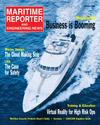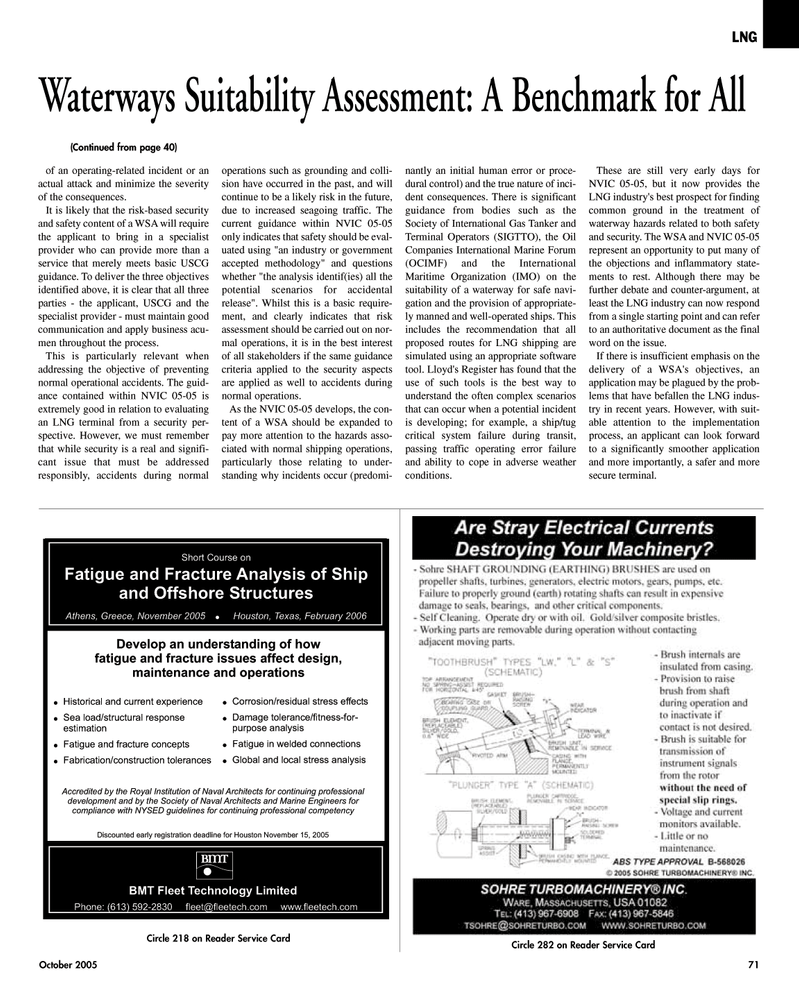
Page 71: of Maritime Reporter Magazine (October 2005)
The Marine Design Annual
Read this page in Pdf, Flash or Html5 edition of October 2005 Maritime Reporter Magazine
October 2005 71 of an operating-related incident or an actual attack and minimize the severity of the consequences.
It is likely that the risk-based security and safety content of a WSA will require the applicant to bring in a specialist provider who can provide more than a service that merely meets basic USCG guidance. To deliver the three objectives identified above, it is clear that all three parties - the applicant, USCG and the specialist provider - must maintain good communication and apply business acu- men throughout the process.
This is particularly relevant when addressing the objective of preventing normal operational accidents. The guid- ance contained within NVIC 05-05 is extremely good in relation to evaluating an LNG terminal from a security per- spective. However, we must remember that while security is a real and signifi- cant issue that must be addressed responsibly, accidents during normal operations such as grounding and colli- sion have occurred in the past, and will continue to be a likely risk in the future, due to increased seagoing traffic. The current guidance within NVIC 05-05 only indicates that safety should be eval- uated using "an industry or government accepted methodology" and questions whether "the analysis identif(ies) all the potential scenarios for accidental release". Whilst this is a basic require- ment, and clearly indicates that risk assessment should be carried out on nor- mal operations, it is in the best interest of all stakeholders if the same guidance criteria applied to the security aspects are applied as well to accidents during normal operations.
As the NVIC 05-05 develops, the con- tent of a WSA should be expanded to pay more attention to the hazards asso- ciated with normal shipping operations, particularly those relating to under- standing why incidents occur (predomi- nantly an initial human error or proce- dural control) and the true nature of inci- dent consequences. There is significant guidance from bodies such as the
Society of International Gas Tanker and
Terminal Operators (SIGTTO), the Oil
Companies International Marine Forum (OCIMF) and the International
Maritime Organization (IMO) on the suitability of a waterway for safe navi- gation and the provision of appropriate- ly manned and well-operated ships. This includes the recommendation that all proposed routes for LNG shipping are simulated using an appropriate software tool. Lloyd's Register has found that the use of such tools is the best way to understand the often complex scenarios that can occur when a potential incident is developing; for example, a ship/tug critical system failure during transit, passing traffic operating error failure and ability to cope in adverse weather conditions.
These are still very early days for
NVIC 05-05, but it now provides the
LNG industry's best prospect for finding common ground in the treatment of waterway hazards related to both safety and security. The WSA and NVIC 05-05 represent an opportunity to put many of the objections and inflammatory state- ments to rest. Although there may be further debate and counter-argument, at least the LNG industry can now respond from a single starting point and can refer to an authoritative document as the final word on the issue.
If there is insufficient emphasis on the delivery of a WSA's objectives, an application may be plagued by the prob- lems that have befallen the LNG indus- try in recent years. However, with suit- able attention to the implementation process, an applicant can look forward to a significantly smoother application and more importantly, a safer and more secure terminal.
LNG
Circle 282 on Reader Service Card
Circle 218 on Reader Service Card c33 Historical and current experience c33 Sea load/structural response estimation c33 Fatigue and fracture concepts c33 Fabrication/construction tolerances
Phone: (613) 592-2830 [email protected] www.fleetech.com
BMT Fleet Technology Limited
Short Course on
Fatigue and Fracture Analysis of Ship and Offshore Structures
Athens, Greece, November 2005 c110 Houston, Texas, February 2006
Develop an understanding of how fatigue and fracture issues affect design, maintenance and operations c33 Corrosion/residual stress effects c33 Damage tolerance/fitness-for- purpose analysis c33 Fatigue in welded connections c33 Global and local stress analysis
Accredited by the Royal Institution of Naval Architects for continuing professional development and by the Society of Naval Architects and Marine Engineers for compliance with NYSED guidelines for continuing professional competency
Discounted early registration deadline for Houston November 15, 2005
Waterways Suitability Assessment: A Benchmark for All (Continued from page 40)
MR OCTOBER 2005 #9 (65-72).qxd 10/3/2005 11:20 AM Page 71

 70
70

 72
72
